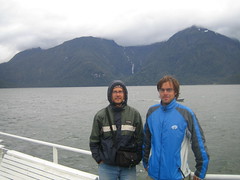The Last Post
Well, we're back. I'm sure half of our regular readers have quit checking by now. Our apologies for leaving it so long.
We left Torreon on the 29th of June, sadly, as we had made some good friends there. After spending four quick hours in Oklahoma City we boarded our LAST bus! I won't miss it. Three days in Tulsa with Piet's grandma and another four days in Nebraska with Piet's family meant we spent July 4th in small town US of A. That night was fun-filled with firecrackers, fireworks, and exploding toilet bowl cleaner.
The old '86 Corolla was less than ready to take us back to Canada. There were no brakes and in searching for the problem we broke two wheel studs and another brake line. After getting it out of the shop, we made it across the street before another brake line burst. It's interesting to think what might have happened had we driven it into the mountains. So, we left with Piet's dad's van, which still has the dent from when I "rear"ended it. We stayed five days with Kris and Tasha in Duluth, having Annika for ample entertainment.
Then we headed for our last border crossing. They searched our stuff for an hour, then kept us an hour more before deciding we actually could drive a US licensed vehicle into Canada. In 15 minutes we heard two Tragically Hip songs and a token tune from Neil Young, leaving no doubt that we were back in the Great White North.
It feels good to be on home soil. I can't figure why, it just does.
Six and a half months, 12 new countries, 49, 807 km (1.2 times around the earth), 817 hours of travelling (just over 34 days on a bus). Ironically there are no truly remarkable stories, meaning nothing extremely funny happened, there are no tales of escape from danger, in short nothing out of which we could write a book and get rich. That said, it was the most remarkable six months of my life, and I know Piet feels the same. What began a year and a half ago as an outrageous idea quickly grew into a dream, which became a reality, and it has left us with the sense that you can do anything you set your mind to. How can we possibly sum up the adventure? I'd like to say wait for the slideshow, because a picture is worth a thousand words, but even though we have eight hours of video and 6000 stills, the pictures don't rival the memories. I guess that's just the way it is. We all have special experiences and thoughts, stuff we have trouble describing or communicating. But that must be the reason they are so special to us, because they are, and can only be, ours, our thoughts, our experiences. It was our adventure, and even if I could, I wouldn't give it up for anything.
Here are some lists which you may or may not find interesting.
Memorable Experiences (impossible to rank)
Scuba Diving
Perito Moreno Glaciar
River Plate Game
Sunrise on the Salar
Tierra del Fuego
Potosi
Santa Maria
Barbeque at Butch and Sundance's place
Ferry in Chile
Hitchhiking
Torreon
Top Five
Torres del Paine
Puerto Madryn
Iguazu Falls
Death Road
Jungle
Numero Uno
Machu Picchu
Some Superlatives
Most beautiful women: #1 Costa Rica, #2 Buenos Aires
Most dogs: Chile
Most dog poop: Buenos Aires
Best food: Chile, Argentina, Mexico, the Baleada (Honduras)
Best coffee: Argentina
Cheapest food: Bolivia
Most diarrhea: Bolivia
Best country: Argentina
Friendliest people: Argentina
Most hospitable: Mexico
Rudest: Peru
Worst border: Peru-Ecuador
Least "westernized": Bolivia
Most "westernized": Ecuador
Windiest place: El Chalten, Argentina
Best Music: Bolivia
Best city: Buenos Aires
Best meal: Boliche de Dario (all you can eat meat)
Best fries: Salta, Argentina
Most gringos: Torres del Paine
Country from which the most tourists came: Israel
Worst busride: Uyuni to Potosi in Bolivia
Nicest buses: Argentina
Worst bus company: Greyhound (by far)
Longest busride: 38 hours from Quito to Lima
Biggest bus terminal: Panama City
Best donut: Costa Rica
Most overplayed song: Noviembre Sin Ti by Reik
Worst Spanish accent:Chile
Most expensive country: Chile
Most butterflies: Iguazu Falls
Most shotguns in the street: Guatemala
Best beach: Manuel Antonio National Park
Worst Beach: Valparaiso, Chile
Biggest dissapointment: Devil's Nose Train
Most fantastic display of nature: Iguazu Falls
Best sunrise: Salar
Best churches: Xela, Guatemala and Arequipa, Peru
Other Stuff:
Total number of Belgians spotted: 8
Major Arguments: 5
Points of homesickness: Ushuaia and Bolivia
Total weightloss: nil
Articles lost:
Clay: 5 towels, 1 pair of glasses, 1 pair of swimming trunks, pocket knife, watch
Pieter: 1 towel, 1 belt, 2 notebooks, 1 bankcard (found), Tim Horton's cup, countless pairs of socks, code to padlock, Central America guidebook
Lastly, it is hard to explain how exciting and strangely comforting it was to know that you were following along. It was kind of fun to have an audience of sorts. For that we want to thank you, and we hope that you've enjoyed it. Take care and God bless!
Sincerely, the Bandidos Yanquis
Butch: I got a great idea where we should go next.
Sundance: I don't want to hear it.
Butch: You'll change your mind when I tell ya.
Sundance: Shut up.
Butch: OK, OK.
Sundance: It's your great ideas that got us here.
Butch: Forget about it.
Sundance: I don't ever want to hear another one of your ideas. All right?
Butch: All right.
Sundance: OK.
Butch: Australia - I figured secretly you wanted to know, so I told ya. Australia.

